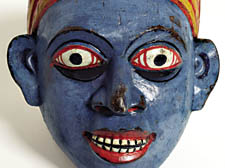|
|
 |
| |

Mask from Sri Lanka. |
Incurable case of curiosity
Sir Henry Wellcome’s extraordinary collection – from Darwin’s walking stick to Nelson’s razor blade – is on show from this week. Dan Carrier reports
SIR Henry Wellcome liked to collect curios – two million items of curios, to be precise. The multi-millionaire who made his fortune as a pharmacist dedicated the last 25 years of his life as a collector of the detritus of humankind in the belief that such a collection would add to the sum of our understanding of the world around us.
Now his vast fascinating miscellany is on show along with contemporary artefacts at London’s latest museum, a stunningly designed exhibition centre in Euston Road – the latest addition to the burgeoning cultural quarter around King’s Cross and Euston.
The artefacts on permanent display include Nelson’s razor blade, Charles Darwin’s walking stick, a lock of George III’s hair, and the guillotine blade that lopped off the head of Jean Carrier, the Jacobin extremist who came to a sticky end in the French Revolution’s ‘reign of terror’.
The opening this week of the museum is the culmination of plans first laid by Sir Henry 100 years ago.
Sir Henry (1853-1936) had co-founded the pharmaceutical company Burroughs Wellcome and gave his fortune to the Trust when he died. His wish was to see a permanent exhibition space created which would consider art and science – something the nine-storey building is now ready to fulfil.
Curator Dr Ken Arnold, who is overseeing the collections, said the man behind the artefacts comes alive through the collection.
He said: “Sir Henry had a particular interest in anthropology and the history of medicine and that was the driving force behind him amassing one of the world’s largest collections relating to health and well-being.”
He acquired a little of everything and lot of some things, from shrunken heads to Florence Nightingale’s moccasins, amputation saws and shields and spears. His staff would search everywhere from auction houses to rag-and-bone men, trying to find everyday items relating to health.”
And then he set about finding a place to house this vast and wonderful collection.
In 1932 Sir Henry had the Wellcome Research Institute in Euston Road built to his specification with the aim of being a permanent home for his vast collection.
Designed by architect Septimus Warwick, the original neoclassical design has since been completely revamped.
The practice run by Hampstead-based architect Sir Michael Hopkins took on the brief with director Edward Williams in charge. He said the project offered a unique opportunity to complete a building that would do the collection justice: “The building was completely gutted in the 1990s. It had been stripped right back. This gave us the chance to consider what the best setting would be for the displays.”
Sir Henry envisaged the ground, first, second and third floors to house large exhibition galleries which he hoped would form the basis of his life-long dream, a Museum of Man.
After building up his fortune as a pharmacist, he spent 25 years funding research parties, putting finance into archaeological digs, and employing people around the world to find him interesting artefacts. Many of the bizarre and diverse pieces he collected were never taken out of their packing crates.
His collection has been supplemented by contemporary objects.
A sculpture by Marc Quinn in the foyer is a cast of a woman who is HIV positive – and the polymer resins used to create her body image includes the retro-viral cocktail of drugs she takes each day. Opposite, and suspended upside down from the ceiling, is one of Anthony Gormley’s body casts.
An exhibition space on the ground floor will be used to house temporary shows – the first is a consideration of the heart in both medical and imaginative terms.
Dr Arnold said: “We thought this would be a great exhibition to open with – it really brings together so many different areas of interest.”
Exhibits are wide and varied: three original heart dissection drawings by Leonardo Da Vinci sit alongside an Italian 17th century anatomical chart that was made by filleting a cadaver, taking out all the arteries and then varnishing them on a slab of wood. A modern heart and lung machine is on display – “its sheer size and complicated workings show how incredible the work our heart, which are such small organs, does,” says Dr Arnold.
A heart has been donated by a lady who recently underwent transplant surgery at the Papworth hospital. Dr Arnold hopes, as she recovers, she will be able to visit to see her own heart on display. There are less bodily exhibits: the role of the heart in country and western songs is explored, with listening posts offering examples, and the giant heart of a sperm whale is compared to that of the hummingbird.
The permanent displays of Sir Henry’s collection is just as varied: that’s how he would have wanted it, says Dr Arnold. “He wanted us to consider the holistic link between science and art,” he says. “His collection, and this museum, dem-onstrates that.”
|
 |
|
| |
|
 |
|

